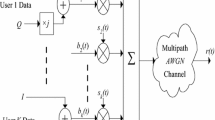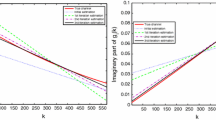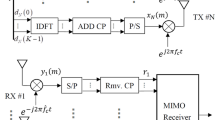Abstract
Parallel interference cancellation (PIC) based channel parameter estimators for frequency selective fading channels are proposed for the uplink in code-division multiple-access (CDMA) mobile communication systems. The performance of PIC based algorithms depends heavily on the quality of the multiple-access interference estimates, which can be improved by using adaptive channel estimation filters. The performance of two adaptive complex channel coefficient estimation filters has been verified in a fading channel by computer simulations. According to the results, the PIC based adaptive channel estimators outperform clearly conventional, successive interference cancellation, and decorrelation based adaptive channel estimators. The PIC method is also used in delay tracking. By using the principles of sample-correlate-choose-largest (SCCL) delay trackers, a robust algorithm for multiuser delay tracking in fading channels is obtained.
Similar content being viewed by others
References
S. VerdÚ, “Multiuser Detection”, Advances in Statistical Signal Processing, Volume 2. JAI Press Inc.: Greenwich, CT, 1993, pp. 369–409.
A. Duel-Hallen, J. Holtzman and Z. Zvonar, “Multiuser Detection for CDMA Systems”, IEEE/ACM Personal Communications — The Magazine of Nomadic Communications and Computing, Vol. 2, pp. 46–58, 1995.
S. Moshavi, “Multiuser Detection for DSCDMACommunications”, IEEE Commun. Mag., Vol. 34, No.10, pp. 124–137, 1996.
M. J. Juntti and S. G. Glisič, “Advanced CDMA for Wireless Communications”, In S. G. Glisič and P. Leppänen, eds., Wireless Communications: CDMA Versus TDMA, chapter 4. Kluwer, 1997.
M. K. Varanasi and B. Aazhang, “Multistage Detection in Asynchronous Code-Division Multiple-Access Communications”, IEEE Trans. Commun., Vol. 38, No.4, 1990.
A. P. Dempster, N. M. Laird and D. B. Rubin, “Maximum Likelihood from Incomplete Data via the EM Algorithm”, Journal of Royal Statistical Society, 1976.
A. Radovič and B. Aazhang, “Iterative Algorithms for Joint Data Detection and Delay Estimation for Code Division Multiple Access Communication Systems”, in Proceedings of the Annual Allerton Conference on Communications, Control, and Computing, Allerton House, Monticello, IL, 1993.
U. Fawer and B. Aazhang, “A Multiuser Receiver for Code Division Multiple Access Communications over Multipath Channels”, IEEE Trans. Commun., Vol. 43, No.2/3/4, pp. 1556–1565, 1995.
J. Fessler and A. Hero, “Space-Alternating Generalized Expectation-Maximization Algorithm”, IEEE Trans. Sign. Proc., Vol. 42, No.10, pp. 2664–2677, 1994.
L. B. Nelson and H. V. Poor, “Iterative Multiuser Receivers for CDMA Channels: An EM-based Approach”, IEEE. Trans. Commun., Vol. 44, No.12: 1700–1710, 1996.
D. Dahlhaus, A. Jarosch, H. Fleury and R. Heddergott, “Joint Demodulation in DS/CDMA Systems Exploiting the Space and Time Diversity of the Mobile Radio Channel”, in Proceedings of the IEEE International Symposium on Personal, Indoor, and Mobile Radio Communications, Helsinki, Finland, September 1–4 1997.
S. Haykin, Adaptive Filter Theory, Prentice Hall: Englewood Cliffs, NJ, 2nd edition, 1991.
Y. Liu and S. D. Blostein, “Identification of Frequency Non-Selective Fading Channels Using Decision Feedback and Adaptive Linear Prediction”, IEEE Trans. Commun., Vol. 43, No.2/3/4, pp. 1484–1492, 1995.
K.C. Chen and L. D. Davisson, “Analysis of a New Bit Tracking Loop SCCL”, IEEE Trans. Commun., Vol. 40, No.1, pp. 199–209, 1992.
W. C. Lindsey and C. M. Chie, “A Survey of Digital Phase-Locked Loops”, Proc. IEEE, Vol. 69, No.4, pp. 410–431, 1981.
M. Latvaaho, M. Juntti and M. Heikkilä, “Parallel Interference Cancellation Receiver for DS-CDMA Systems in Fading Channels”, in Proceedings of the IEEE International Symposium on Personal, Indoor, and Mobile Radio Communications, Helsinki, Finland, September 1–4 1997.
A. Mämmelä and V.P. Kaasila, “Smoothing and Interpolation in Diversity Reception”, International Journal of Wireless Information Networks, to appear, 1997.
P. M. Grant, G. J. R. Povey and R. D. Pringle, “Performance of a Spread Spectrum RAKE Receiver Design”, in Proceedings of the IEEE International Symposium on Spread Spectrum Techniques and Applications, Yokohama, Japan, November 29–December 2, 1992, pp. 71–74.
C. S. Lindquist, “Adaptive & Digital Signal Processing with Digital Filtering Applications”, Steward & Sons: Miami, 1989.
J. J. Spilker and D. T. Magill, “The Delay-Lock Discriminator An Optimum Tracking Device”, Proceedings of the IRE, Vol. 49, pp. 1403–1416, 1961.
U. Fawer, “A Coherent Spread-Spectrum Diversity-Receiver with AFC for Multipath Fading Channels”, IEEE Trans. Commun., Vol. 42, No.2/3/4, pp. 1300–1311, 1994.
P. Patel and J. Holtzman, “Analysis of a Simple Successive Interference Cancellation Scheme in a DS/CDMA System”, IEEE Journal on Selected Areas in Communications, Vol. 12, No.10, pp. 796–807, 1994.
Z. Zvonar and D. Brady, “Suboptimal Multiuser Detector for Frequency-Selective Rayleigh Fading Synchronous CDMA Channels”, IEEE Trans Commun., Vol. 42, No.2/3/4, pp. 1729–1739, 1994.
M. J. Juntti and B. Aazhang, “Finite MemoryLength Linear Multiuser Detection for Asynchronous CDMA Communications”, IEEE Trans. Commun., Vol. 45, No.5, pp. 611–622, 1997.
A. Radovič, “An Iterative NearFar Resistant Algorithm for Joint Parameter Estimation in Asynchronous CDMA Systems”, in Proceedings of the IEEE International Symposium on Personal, Indoor, and Mobile Radio Communications, pp. 199–203.
S. E. Bensley and B. Aazhang, “Subspace-Based Channel Estimation for Code Division Multiple Access Communication Systems”, IEEE Trans. Commun., Vol. 44, No.8, pp. 1009–1019, 1996.
E.G. Ström and S. Parkvall, “Joint Parameter Estimation of DS-CDMA Signals in Fading Channels”, in Proceedings of the IEEE Global Telecommunication Conference, Vol. 2, pp. 1109–1113, Singapore, November 13–17, 1995.
M. Feder and E. Weinstein, “Parameter Estimation of Superimposed Signals Using the EM Algorithm”, IEEE Transactions on Acoustics, Speech, and Signal Processing, Vol. 36, No.4, 477–489, 1988.
P.Y. Kam, “Optimal Detection of Digital Data over the Nonselective Rayleigh Fading Channel with Diversity Reception”, IEEE Trans. Commun., Vol. 39, No.2, pp. 214–219, 1991.
Author information
Authors and Affiliations
Rights and permissions
About this article
Cite this article
Latva-aho, M., Lilleberg, J. Parallel Interference Cancellation in Multiuser CDMA Channel Estimation. Wireless Personal Communications 7, 171–195 (1998). https://doi.org/10.1023/A:1008804628363
Issue Date:
DOI: https://doi.org/10.1023/A:1008804628363




